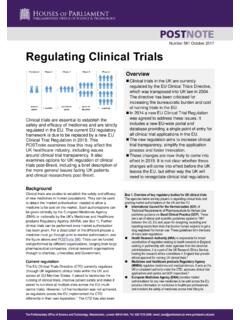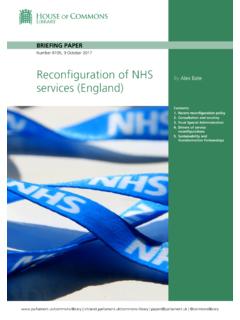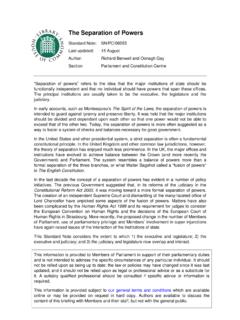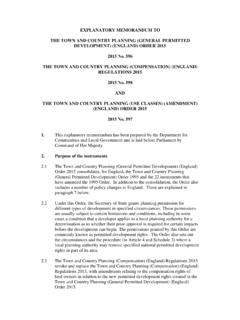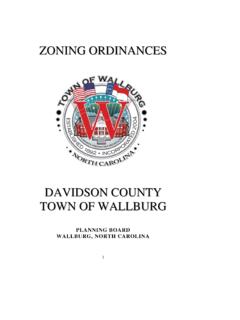Transcription of Permitted Development Rights
1 | | | @commonslibrary BRIEFING PAPER Number 00485, 14 June 2017 Permitted Development Rights By Louise Smith Inside: 1. Permitted Development Rights 2. Local authority ability to suspend Permitted Development Rights (Article 4 Directions) 3. Key recent changes to Permitted Development Rights 4. Future proposals Number 00485, 14 June 2017 2 Contents Summary 3 1. Permitted Development Rights 4 Neighbour consultation scheme 4 change of use 4 Prior approval 5 2. Local authority ability to suspend Permitted Development Rights (Article 4 Directions) 6 3. Key recent changes to Permitted Development Rights 8 Home and business extensions 8 Comment on extending Permitted Development Rights to home extensions 10 Telecommunications masts and mobile connectivity 11 Reform of General Permitted Development Order and new Permitted Development Rights : 2015 12 Shale gas and oil monitoring and investigation 17 Prior approval for building operation Permitted Development 18 Drinking establishments 18 4.
2 Future proposals 20 Rural areas 20 Conservative Party 2017 manifesto 21 Cover page image copyright: Harvesting the sun. Copyright Anthony Vosper and licensed for reuse under this Creative Commons Licence / image cropped. 3 Permitted Development Rights Summary This briefing paper applies to England only. For information about Permitted Development in the other UK countries see section 8 of the joint Library briefing paper Comparison of the planning systems in the four UK countries: 2016 update. What are Permitted Development Rights ? Permitted Development Rights are Rights to make certain changes to a building without the need to apply for planning permission. These derive from a general planning permission granted by Parliament, rather than from permission granted by the local planning authority. Before some Permitted Development Rights can be used, the developer must first obtain prior approval in relation to specified aspects of the Development from the local planning authority.
3 Some Permitted Development Rights cover building operations, such as home extensions, whereas others cover change of use of buildings. change of use Permitted Development Rights , such as office to residential conversion, are covered in another Library briefing paper, Planning: change of use. Removing Permitted Development Rights In some circumstances local planning authorities can suspend Permitted Development Rights in their area, under Article 4 of the Town and Country Planning (General Permitted Development ) (England) Order 2015. Recent changes From 15 April 2015 the Town and Country Planning (General Permitted Development ) (England) Order 2015 consolidated and revoked the previous 1995 legislation relating to Permitted Development in England. It also introduced a number of new Permitted Development Rights , including the provision of click-and-collect services by shops and to enable greater use of non-domestic properties to provide renewable energy.
4 In May 2013 changes came into force to allow Permitted Development for home extensions; to increase the size limits for the depth of single-storey domestic extensions from 4m to 8m (for detached houses) and from 3m to 6m (for all other houses), in non-protected areas, for a period of three years. A neighbour consultation scheme on new extensions was introduced by the then Government in response to concerns about the original proposals. This temporary Permitted Development has now been extended until May 2019. Changes were also made in November 2016 to allow for taller mobile masts in a bid to boost mobile connectivity. Future proposals In February 2017 the previous Government began a consultation on extending the existing thresholds for Permitted Development Rights for agricultural Development on agricultural units of 5 hectares or more. It also proposed a new agricultural to residential use Permitted Development right which would allow conversion of up to 750sqm, for a maximum of 5 new dwellings, each with a floor space of no more than 150sqm.
5 The Conservative Party manifesto for the 2017 general election indicated that non-fracking drilling would be made Permitted Development . The new Government has not yet confirmed this position since the election and the appointment of a new Housing and Planning Minister. Number 00485, 14 June 2017 4 Legislation from April 2015 brought new Permitted Development Rights into force and replaced the previous law. Permitted Development Rights do not apply in all areas. 1. Permitted Development Rights Permitted Development Rights are basically Rights to make certain changes to a building without the need to apply for planning permission. These derive from a general planning permission granted by Parliament, rather than from permission granted by the local planning authority. Until recently, Permitted Development Rights were set out in the Town and Country Planning (General Permitted Development ) Order 1995 (No. 418) (the1995 Order).
6 They are now, since 5 April 2015, contained in the Town and Country Planning (General Permitted Development ) (England) Order 2015 (No. 596) (the 2015 Order). Schedule 2 of this Order sets out the scope of Permitted Development Rights . In some areas, called designated areas , Permitted Development Rights are more restricted. These are generally in conservation areas, a National Park, an Area of Outstanding Natural Beauty or the Norfolk or Suffolk Broads. In designated areas planning permission will be needed to carry out the changes to the building. It does not necessarily mean that the changes cannot be made, but simply that the local planning authority will want to consider the proposals in detail first. Restrictions also apply if the property is a listed building. The Planning Portal website has guides about the rules relating to some of the most frequently used Permitted Development Rights . These include: Domestic solar panels; Extensions; Loft conversions; Outbuildings; and Satellite, TV and radio antenna.
7 Neighbour consultation scheme Before some Permitted Development Rights can be used, for example for larger single-storey rear extensions, there is a neighbour consultation scheme requirement which requires notifying the local planning authority of what is proposed. The local authority will serve a notice on adjoining owners or occupiers, those who share a boundary, including to the rear. If any adjoining neighbour raises an objection within the 21-day period, the local authority will take this into account and make a decision about whether the impact on the amenity of all adjoining properties is acceptable. For further information about the scheme and its requirements see HM Government, Permitted Development Rights for Householders: Technical Guidance, April 2017. change of use The Town and Country Planning (Use Classes) Order 1987 puts uses of land and buildings into various categories known as Use Classes . The categories give an indication of the types of use which may fall within each use class.
8 There are four main categories: 5 Permitted Development Rights Class A covers shops and other retail premises such as restaurants and bank branches; Class B covers offices, workshops, factories and warehouses; Class C covers residential uses; and Class D covers non-residential institutions and assembly and leisure uses. These categories are then further split up into a number of subclasses. The Town and Country Planning (General Permitted Development ) (England) Order 2015 then grants Permitted Development Rights for change of use where planning permission is not needed for changes in use of buildings within each subclass and for certain changes of use between some of the classes. Permitted Development Rights relating to a change of use of buildings is covered in a separate Library briefing paper, Planning: change of Use, SN/SC/01301. Prior approval For many Permitted Development Rights which relate to change of use of buildings there is a prior approval system, set out in the 2015 Order, which requires the LPA to approve technical aspects of the Development , such as its siting, design and transport and highways issues.
9 These pre-approval requirements vary depending on the exact type of change of use Permitted Development right. If the LPA decides to refuse prior approval on these issues then the change of use may not go ahead. Further information about prior approval, what it is and when it is required is provided in the Planning Practice Guidance. Number 00485, 14 June 2017 6 Permitted Development Rights can be removed if a local authority makes an article 4 direction . 2. Local authority ability to suspend Permitted Development Rights (Article 4 Directions) In some circumstances local planning authorities can suspend Permitted Development Rights (including those relating to change of use) in their area. Local planning authorities have powers under Article 4 of the 2015 Order to remove Permitted Development Rights . While article 4 directions are confirmed by local planning authorities, the Secretary of State must be notified, and has wide powers to modify or cancel most article 4 directions at any Article 4 directions must be made in accordance with national Government guidance given in the National Planning Policy Framework which directs that there must be a clear justification for removing national Permitted Development Rights : 200.
10 The use of Article 4 directions to remove national Permitted Development Rights should be limited to situations where this is necessary to protect local amenity or the wellbeing of the area (this could include the use of Article 4 directions to require planning permission for the demolition of local facilities). Similarly, planning conditions should not be used to restrict national Permitted Development Rights unless there is clear justification to do so. The online Planning Practice Guidance (PPG) which accompanies the NPPF states that provided there is justification for both its purpose and extent, it is possible to make an article 4 direction covering: cover an area of any geographic size, from a specific site to a local authority-wide area remove specified Permitted Development Rights related to operational Development or change of use remove Permitted Development Rights with temporary or permanent effect2 There are circumstances in which local planning authorities may be liable to pay compensation having made an article 4 direction.




